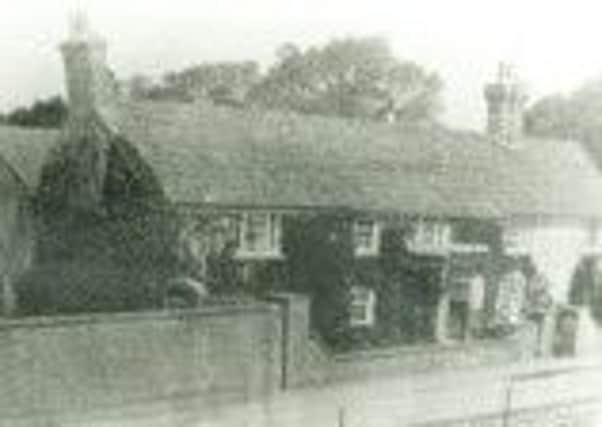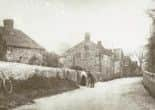Midnight journey to Lancing


I checked the Bren gun safety catch, placed my loaded FN rifle at a useful angle and stared through the darkness at the barbed wire perimeter fence. If terrorists did attack, my job was to hold them off until the rest of the guard turned out.
I was 18. Another National Service soldier drafted to another trouble spot. The year was 1956.
Advertisement
Hide AdAdvertisement
Hide AdGuard duties could last several weeks. In the long hours, especially at night, thoughts turned to home and the people left behind.


One way of passing the dark hours was to go on imaginary journeys. Walking from my home along the main street of Lancing – North Road – to my father’s shop was one of my favourites.
We lived in a semi-detached cottage next to Lancing Tabernacle. Originally intended for farm-workers, the cottages had brown pebble dashed walls and long back gardens.
Opening the front garden gate, I looked across to the houses grouped round a square of rough grass – Addison Square.
Advertisement
Hide AdAdvertisement
Hide AdI knew most of the people because I delivered newspapers to their door. And I knew their dogs, especially the black and white mongrel that ambushed me most mornings.
My father had purchased an old shop close to the railway line; a shop that, a year previously, had been the main post-office for Lancing.
Lit by gas lamps, the early morning air smelled of newsprint and damp. We sold newspapers, cigarettes, tobacco and various oddments. I’m not sure why, but I always remember a toilet roll called Bronco.
Assisting my father in the shop from 6.30am until 8am, I prepared the newspapers for delivery, served customers and delivered papers if a boy/girl failed to arrive. Then I went to school.
Advertisement
Hide AdAdvertisement
Hide AdLancing was growing quickly. So quickly the old seven square foot sorting shed at the back of the shop was redundant.
It seemed incredible that all the mail for Lancing had once been sorted and delivered from this tiny shed. But now a new post office had been built on the other side of North Road. A huge structure compared with the rusting old shed at the back of our shop.
In 1930, the population of Lancing was 5,000. By 1950, the village had grown to 12,000. Now, it is home to nearly 19,000 people, and North Road has become the retail hub of one of England’s largest villages.
Looking back in time, the pair of farm cottages next to the Tabernacle has been replaced by council offices, and the old houses in Addison Square knocked down and replaced by a modern, high- density development.
Advertisement
Hide AdAdvertisement
Hide AdIn the 1950s, North Road still retained a rural character; old houses, ancient trees, horses grazing in a paddock on the corner of North Farm and North Road.
Opposite the paddock stood two old, ivy-clad detached houses: Myrtle Lodge and Laurel Lodge.
The horses belonged to author and teacher Alan Kennington. He lived with his family in Laurel Lodge.
In the tree-shrouded back garden of Myrtle Lodge the owner kept bee hives. Occasionally, I would glimpse a white-robed figure carrying a net. Perhaps the bees had escaped?
Advertisement
Hide AdAdvertisement
Hide AdApproaching the next house, especially on dark mornings, was a scary prospect. It was a dark, ugly house. We called it Staker’s House.
Mr Staker was a wild looking man, very fierce, a cattle dealer. His two sons were smaller versions of their father.
I skipped quickly between the house and the large cattle truck parked in the road. The smell of the caged cattle, the sudden grunt as I passed by, hurried me past and onto safer ground.
An old flint wall with apple trees peeping over the top came next. Behind the high walls lay a most curious home. It was formed of two railway carriages complete with communication cord – £5 penalty if you pull this cord without due reason – sliding windows with leather straps and First Class printed in blue on the windows.
Advertisement
Hide AdAdvertisement
Hide AdMr and Mrs Shearing, and their son Barry, lived in the carriage home.
This part of North Road has been demolished and a parade of shops built in the space – Queen’s Parade.
The paddock on the corner of North Farm Road has become the site of a small block of flats called North Farm Court.
What remains from this period are the Penfold Memorial Alms Houses, on the east side of North Road.
Advertisement
Hide AdAdvertisement
Hide AdOpposite the Alms Houses, Culverhouse Farm had been knocked down and replaced by Cecil Parade.
The first shop, called The Cabin, sold sweets and chocolate; the second was a fruit and veg shop, managed by by two women; then a butcher’s shop owned by Mrs Graham, who lived in a bungalow in Culver Road.
My imaginary journey continued past the fish shop run by Mr Bell. Then my favourite – the Lancing ICP (ice cream parlour).
In the 1950s, this shop appeared so sophisticated, so Hollywood American. And it had a large “nickel-odeon” that played the latest 45 rpm vinyl records.
Advertisement
Hide AdAdvertisement
Hide AdTo sit at the counter on a tall chair, sipping a Pepsi and chatting with friends seemed to me as good as life could get.
Flinn’s dry cleaners, Mr Watson’s hair salon and a grocer’s shop followed.
Then, on a cold winter’s morning, wafted the smell of fresh bread – Spurrier’s the bakers. The lights from the bakehouse shone brightly through the darkness.
On the east side of North Road stood a terrace of old houses with long front gardens and a well.
Advertisement
Hide AdAdvertisement
Hide AdLittlecroft was the home of a group of old Lancing families. Steve Stringer was the sexton at North Lancing Church, and also parish clerk.
Mr Comper and Mr Cass lived at 3 and 4 Littlecroft, Mr Blaker and Mr Robinson at 1 and 2.
Littlecroft was demolished in the 1960s and a parade of shops, Queensway, built. Under the paving slabs lies the old well.
Still on the east side were four old houses that were privately occupied. Mr Flook, a sign-maker, lived in one, Mrs Goodbody in another, then South Lancing County Primary School and the newly erected Lancing post office.
Advertisement
Hide AdAdvertisement
Hide AdAhead of me the early London train thundered past the level crossing signal box. In the after silence birds were calling from the bushes of a derelict garden.
Once, a large house had stood here – the high wall at the front remained – called Furst House; the one-time home of the Doll family. Later, the site became a large Woolworth’s, International Stores and a chemist shop.
Past the high wall that still guarded Furst Haus, past Beehive confectioners, Peters Boot repairs, and Martin Snelling, the butcher; then a passageway that led to Lancing Press and the old post- sorting shed.
Almost there, our shop, Forshaw’s at 7 North Road.
My father was cutting the twine that tied the bundles of newspapers together. The smell of newsprint, the musty shop, combined with the hissing gas lights...
Advertisement
Hide AdAdvertisement
Hide AdAt 2am on a dark Cypriot night, another guard duty was ending. Another journey finished.
“Halt! Who goes there?”
“Sergeant of the guard.”
“Advance and be recognised.”
• Do you have any memories of North Road which you would like to share?
• Send your memories and photos to James Connaughton, via email to [email protected], send them by post or pop into Cannon House, Chatsworth Road, Worthing, BN11 1NA. Telephone 01903 282351.